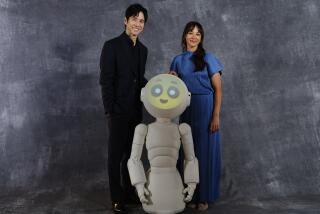Robot Conducts Himself Classically
- Share via
TOKYO — As the lights came up, the conductor was asleep at the podium.
Slowly, he raised himself to his feet, then confessed to the audience that he was nervous. Then he asked the first violinist to play a tune, and danced a bit to calm down. An assistant put the baton into his hand, whereupon the conductor jabbed the air dramatically to commence the famous da-da-da-dum of Beethoven’s Fifth Symphony. Ninety seconds later, he abruptly stopped and was carried offstage -- his ears glowing green -- to ecstatic applause.
By now, you may have guessed that the conductor at Saturday’s concert here wasn’t Seiji Ozawa or Zubin Mehta. Instead, he was a robot with extraordinarily agile hips, hands, legs and fingers. For their part, the human members of the Tokyo Philharmonic Orchestra responded with enthusiasm, aware that a little bit of history was being made: The 23-inch Sony QRIO (pronounced “curio”) had just become the first robot to conduct an orchestra.
Not that the classical world should expect a rash of robot concerts anytime soon. QRIO cannot read music, and his movements are entirely preprogrammed.
He adds no individual interpretation to the piece, and wouldn’t even notice if the orchestra struck up “Bolero” instead of Beethoven’s Fifth. QRIO is, however, a crowd-pleaser. It isn’t every day that you see an audience of mostly elementary school students cheering to classical music.
Saturday’s concert -- the brainchild of the Japan Arts Corp., which represents Japanese classical musicians -- was held to help children appreciate orchestral music. Apart from QRIO’s brief appearance, the concert also featured music from the anime series “Astro Boy,” whose title character, the audience was appropriately reminded, envisions a world in which robots and humans can be friends.
Certainly, the young audience was inspired. “The robot was really fun, and he has cute eyes,” said Leo Nukui, an 8-year-old Tokyo boy. “I was impressed that he had been practicing so hard for the concert.”
QRIO, though a classical music pioneer, isn’t alone in the robot world. Little by little, the lively machines have become a part of Japanese life. Sony has already introduced the popular AIBO robot dog, and Omron Corp. created the NeCoRo, a furry robot cat designed for petting. In Kawasaki, near Tokyo, diners at a Chinese restaurant have had the novelty of being greeted by a robot waitress. Last week, Toyota unveiled a robot that could play the trumpet, by virtue of artificial lips.
But most of these robots have one thing in common: They cannot manage many of the simple tasks that a human (or cat or dog) can. For science-fiction fans, a robot waitress may be a fantasy come true, but she cannot as yet answer simple queries. Robot soccer competitions reveal that even the most sophisticated machine lacks the coordination of a 5-year-old, let alone the strategic sense of a professional.
Experts argue that robot technology has made great strides in recent years.
Honda’s ASIMO robot, for example, is praised for its ability to walk across uneven ground and climb stairs. Nevertheless, humanoid robots lag decades behind industrial robots in terms of function.
For now, the main use of humanoid robots may be as icons of the companies that make them. “QRIO is an ambassador of our company, and is important in conveying what we can do to our customers,” Sony spokesman Yoshikazu Ochiai said.
“Rather than reading some complicated written explanations, people can, we hope, just look at him and see our technological prowess.”
Most robot fans seem to view humanoid machines in romantic rather than technical terms.
“With all the terrible things happening in the world today, it was nice to see the robot conducting and to think about what will one day be possible,” said Kaori Sion, a flutist who attended the concert with her son. “I felt cheerful and hopeful for the future.”
*
Rie Sasaki of The Times’ Tokyo Bureau contributed to this report.
More to Read
The biggest entertainment stories
Get our big stories about Hollywood, film, television, music, arts, culture and more right in your inbox as soon as they publish.
You may occasionally receive promotional content from the Los Angeles Times.










